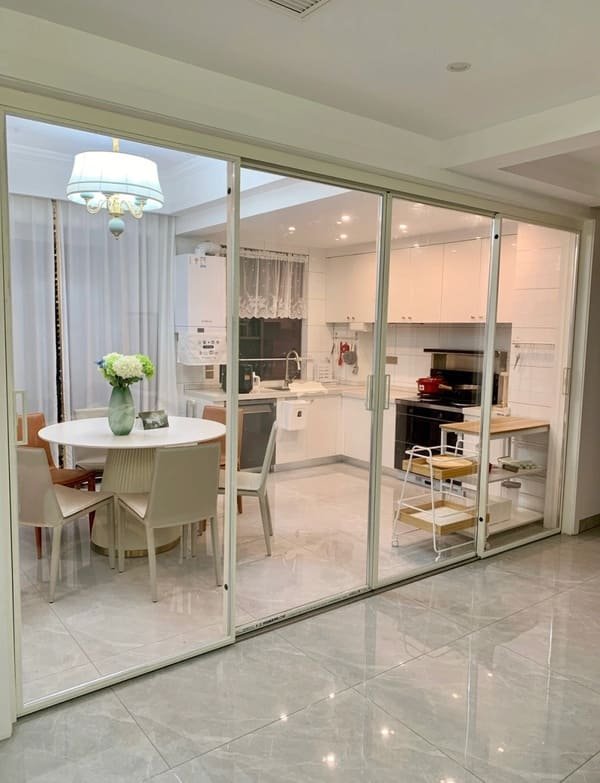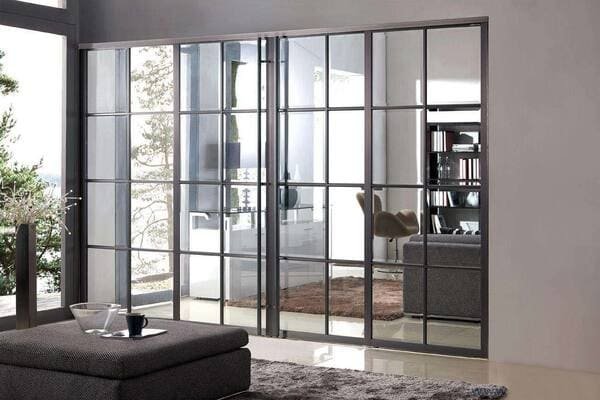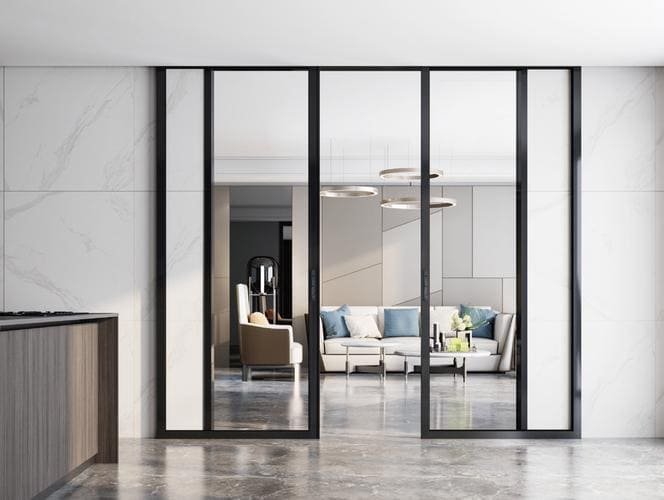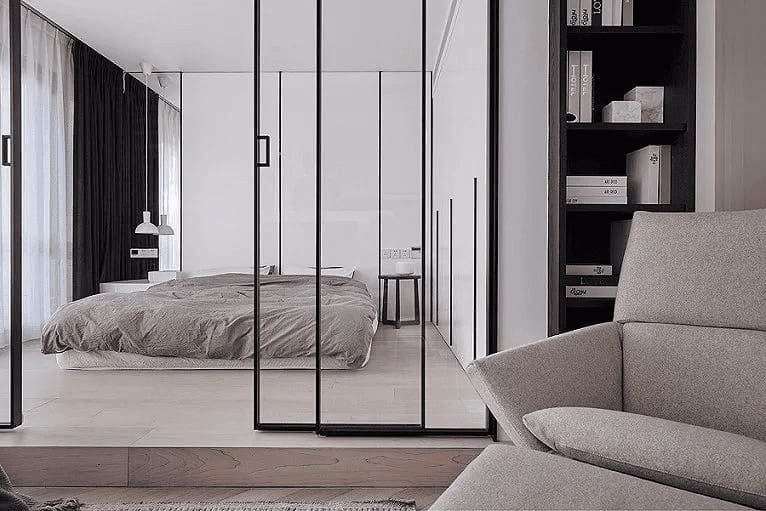Struggling to choose the right sliding door? The wrong thickness affects safety, energy efficiency, and overall performance. I’ll explain the standard measurements to help you make a better choice.
A sliding door’s thickness varies based on its components. The overall door panel is typically 1 3/8 to 1 3/4 inches thick. The glass itself ranges from 5mm (3/16 inch) for basic panes to over 1 inch for high-performance insulated units.

Understanding these basic numbers is a great start, but the real story is in the details. The right thickness depends on the door’s material, its location, and the performance you expect from it. As a manufacturer, I deal with these specifications every day. Let’s break down what these measurements mean for your project so you can source your products with confidence.
How thick is a sliding door?
Confused by all the different thickness measurements? A bad choice can lead to poor performance and a flimsy feel. Let’s break down the common measurements you need to know.
A standard sliding door panel, which includes the frame around the glass, is typically between 1 3/8 inches and 1 3/4 inches (35mm to 45mm) thick. This is a critical measurement for fitting hardware and ensuring the door is strong and stable.

When we talk about the thickness of a sliding door, we are usually referring to the entire moving panel, not just the glass. This panel includes the frame material that holds the glass in place. The thickness of this panel is crucial because all the hardware—the rollers, handles, and locks—is designed to fit these standard dimensions. For a purchasing manager like Jacky, ordering doors or hardware that match these standards simplifies procurement and guarantees compatibility. A thicker door generally feels more solid and provides better insulation and security.
Frame Material and its Effect on Thickness
The material used for the door frame plays a big role in its final thickness. Different materials offer different benefits in terms of strength, appearance, and insulation.
- Wood1: Wood1en sliding door frames have a classic look and provide excellent natural insulation. They are often on the thicker side, typically 1 3/4 inches (45mm), to ensure stability and prevent warping.
- Aluminum2: Aluminum2 frames are prized for their strength and ability to have slim, modern profiles. Even with a thinner look, they maintain structural integrity and are usually between 1 1/2 inches to 1 3/4 inches thick.
- Vinyl (uPVC): Vinyl is a popular, cost-effective choice that offers great insulation. The thickness is comparable to other materials, generally falling in the 1 3/8 inch to 1 3/4 inch range.
Thickness Comparison of Frame Materials
| Frame Material | Typical Panel Thickness | Key Benefits |
|---|---|---|
| Wood | 1 3/4" (45mm) or more | Excellent insulation, classic appeal |
| Aluminum | 1 1/2" to 1 3/4" (38-45mm) | Strong, allows for slim and modern designs |
| Vinyl (uPVC) | 1 3/8" to 1 3/4" (35-45mm) | Cost-effective, low maintenance, good insulation |
| Fiberglass | 1 3/4" (45mm) | Extremely durable, resists weather, low maintenance |
What are standard sizes for sliding doors?
Planning an installation but not sure about standard sizes? Ordering the wrong size door is a costly and frustrating mistake. Here are the common dimensions to guide your project planning.
Standard sliding doors are most often 80 inches (6 feet 8 inches) tall. Common widths are 60 inches (5 feet), 72 inches (6 feet), and 96 inches (8 feet). Knowing these standards makes ordering and installation much easier and more affordable.

Working with standard sizes is a smart move for any large-scale project or distribution business. It streamlines the entire process, from design to installation. In the industry, we often use codes to describe these sizes. For example, a door that is 5-feet wide and 6-feet 8-inches tall is called a "5068". This simple system makes communication between suppliers, contractors, and buyers crystal clear. While custom sizes are always an option for unique architectural designs, sticking to standard dimensions offers significant advantages.
Why Standard Sizes Benefit Professional Buyers
For a seasoned purchaser, the benefits of standard sizes are obvious.
- Cost-Effectiveness3: Manufacturing standard-sized doors in bulk is more efficient, which lowers the cost per unit. This saving is passed on to you.
- Availability: Standard sizes are more likely to be in stock at factories and distributors, leading to much shorter lead times compared to custom orders.
- Hardware Compatibility4: The entire ecosystem of door hardware, from rollers like ours at opensliding to locks and handles, is built around these standard dimensions. This ensures a wide selection and guaranteed fit.
Common Standard Sliding Door Sizes
| Standard Width | Standard Height | Industry Code |
|---|---|---|
| 60 inches (5’0") | 80 inches (6’8") | 5068 |
| 72 inches (6’0") | 80 inches (6’8") | 6068 |
| 96 inches (8’0") | 80 inches (6’8") | 8068 |
| 72 inches (6’0") | 96 inches (8’0") | 6080 |
What is the standard thickness of a glass door?
Is choosing the right glass thickness a headache? The wrong choice can result in poor energy efficiency and safety risks. Let me simplify the standard options for your project.
For sliding doors, the glass thickness itself usually ranges from 5mm (about 3/16 inch) for a basic single pane to over 25mm (1 inch) for an Insulated Glass Unit (IGU). The right choice depends on your needs for insulation, security, and noise reduction.

The glass is the heart of a sliding door, and its specifications have a huge impact on performance. A simple, thin pane of glass might be fine for an internal divider, but it’s not suitable for an exterior wall, especially in a climate like Canada. For exterior applications, safety and energy efficiency are top priorities. That’s why most modern sliding doors use more advanced glass options.
Single Pane vs. Insulated Glass Unit (IGU)5
The biggest decision is between a single pane of glass and an IGU.
- Single Pane Glass6: This is a single layer of glass. By law in most places, it must be safety glass, either tempered or laminated. Tempered glass is stronger than normal glass and shatters into small, blunt pieces. Laminated glass has a plastic interlayer that holds the glass together if it breaks.
- Insulated Glass Unit (IGU)5: This is also called double-glazing. It consists of two panes of glass separated by a sealed space filled with air or an inert gas like argon. This gap acts as a thermal barrier, dramatically reducing heat transfer. This keeps the building warmer in the winter and cooler in the summer, saving on energy bills. The total thickness of an IGU is much greater than a single pane.
Factors Influencing Glass Thickness Choice
| Glass Type | Total Thickness Range | Best Use Case |
|---|---|---|
| Single Pane (Tempered) | 5mm – 10mm (3/16" – 3/8") | Interior applications or mild climates |
| Laminated Glass | 6mm – 12mm (1/4" – 1/2") | High-security or soundproofing needs |
| Insulated Glass Unit (IGU)1 | 16mm – 25mm+ (5/8" – 1"+) | Most exterior doors, for energy efficiency |
What is the common thickness of a door?
Wondering how sliding doors compare to regular doors? Their thickness differs for a reason, affecting security and overall use. Let’s review the common standards for both types.
The most common thickness for a standard interior door is 1 3/8 inches (35mm). For exterior doors, the standard is thicker at 1 3/4 inches (45mm) for better security and insulation. Modern sliding doors typically match the exterior door standard.

Not all doors are created equal, and their thickness is one of the most important distinctions. The function of the door—whether it’s for a bedroom closet or a front entryway—dictates how it’s constructed. Understanding this difference helps put the thickness of A sliding door into context. As a hardware manufacturer, we have to produce different systems for these varying thicknesses and weights.
Interior Door Thickness
Interior doors7 are designed to provide privacy and separate spaces within a building. They are not exposed to weather and don’t require high levels of security. For this reason, they are typically lighter and thinner. The industry standard of 1 3/8 inches is sufficient for these tasks. Many are made with a hollow core to reduce cost and weight, making them easier to install and operate.
Exterior Door Thickness
Exterior doors8 are a building’s first line of defense against intruders and the elements. They must be strong, durable, and well-insulated. The standard thickness of 1 3/4 inches provides the necessary heft and rigidity for security. It also allows for a solid core and better insulation materials. A sliding patio door is considered an exterior door. That’s why it’s built to this thicker standard, and why it uses safety glass and often an IGU. It has to perform just as well as your main front door.
Conclusion
A door’s thickness depends on its location and material. Glass thickness directly impacts safety and energy costs. Knowing these industry standards helps you choose the best products for your project.
Explore the advantages of wooden door frames, including insulation and aesthetic appeal, to make an informed choice. ↩ ↩ ↩
Discover the benefits of aluminum door frames, such as strength and modern design, to enhance your home’s style. ↩ ↩
Understanding cost-effectiveness can help you make informed purchasing decisions and maximize your budget. ↩
Exploring hardware compatibility ensures you choose the right components for a seamless door installation. ↩
Explore the advantages of IGUs for energy efficiency and comfort in your home. ↩ ↩
Learn about the benefits and drawbacks of single pane glass to make an informed decision. ↩
Explore this link to understand the specifications and benefits of interior doors, enhancing your knowledge on home design. ↩
Discover insights on exterior door materials and their importance for security and insulation, crucial for any homeowner. ↩

